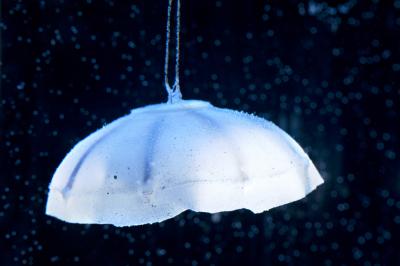Jellyfish energy efficiency to improve bio-inspired robotic designs for Navy
October 22, 2013

This
bio-inspired robotic jellyfish was designed by Shashank Priya,
professor of mechanical engineering, and a research team at the Center
for Energy Harvesting Materials and Systems at Virginia Tech Institute
(credit: Virginia Tech)
Possible civilian applications include pollution monitoring, ecological studies, and cleaning oil in water.
Researchers have found that rather than moving continuously through water while swimming, jellyfish use a critical pause between the contraction and expansion of their bell-shaped body to create a vortex that pushes them forward.
In essence, the creature displaces the water behind them, creating a “hole” that when re-filled propels them forward.
This feat of motion allows the creature to travel 30 percent farther each stroke cycle, thereby reducing metabolic energy demand by swimming muscles, said Shashank Priya, professor of mechanical engineering and Turner Fellow, who led Virginia Tech efforts on the project.
Researchers also found that the jellyfish in the study displayed a lower cost of transport — the amount of food and oxygen taken in by the body, versus energy spent in movement — 48 percent lower than other animals in similar studies. This quick action with minimal energy spent also helps jellyfish in hunting for food.
Computational modeling
The study was led by the Marine Biological Laboratory, based in Woods Hole, Mass., along with Virginia Tech; Providence College and Roger Williams University, both of Rhode Island; and California Institute of Technology. Priya’s team led computational modeling efforts, taking video of the jellyfish movements filmed in laboratory water tanks, and translating that information to computer animation.
The computer modeled jellyfish allows researchers to control movements of the creature however fast they wish, and in any desired direction. The virtual effort is similar to motion-capture filming of actors for later computer-animated visual effects.
Jellyfish have long been known as having a simple muscular makeup and being inefficient swimmers that rely on the current flow of water to navigate. Yet, the ability to conserve energy even while moving may help explain why jellyfish bloom and inundate ecosystems, or even man-made systems, such as ports and dockyards.
The researchers hope to replicate the unique forward propulsion movement into the robotic jellyfish, thereby designing a vehicle that uses the least amount of battery power to go a greater distance.
“Jellyfish are attractive candidates to mimic because of their ability to consume little energy owing to a lower metabolic rate than other marine species, survivability in varying water conditions, and possession of adequate shape for carrying a payload,” Priya said in 2012 when several of the smaller robotic jellyfish were unveiled.
“They inhabit every major oceanic area of the world and are capable of withstanding a wide range of temperatures and in fresh and salt waters. Most species are found in shallow coastal waters, but some have been found in depths 7,000 meters below sea level.”
Abstract of PNAS paper
Gelatinous zooplankton populations are well known for their ability to take over perturbed ecosystems. The ability of these animals to outcompete and functionally replace fish that exhibit an effective visual predatory mode is counterintuitive because jellyfish are described as inefficient swimmers that must rely on direct contact with prey to feed. We show that jellyfish exhibit a unique mechanism of passive energy recapture, which is exploited to allow them to travel 30% further each swimming cycle, thereby reducing metabolic energy demand by swimming muscles. By accounting for large interspecific differences in net metabolic rates, we demonstrate, contrary to prevailing views, that the jellyfish (Aurelia aurita) is one of the most energetically efficient propulsors on the planet, exhibiting a cost of transport (joules per kilogram per meter) lower than other metazoans. We estimate that reduced metabolic demand by passive energy recapture improves the cost of transport by 48%, allowing jellyfish to achieve the large sizes required for sufficient prey encounters. Pressure calculations, using both computational fluid dynamics and a newly developed method from empirical velocity field measurements, demonstrate that this extra thrust results from positive pressure created by a vortex ring underneath the bell during the refilling phase of swimming. These results demonstrate a physical basis for the ecological success of medusan swimmers despite their simple body plan. Results from this study also have implications for bioinspired design, where low-energy propulsion is required.
(¯`*• Global Source and/or more resources at http://goo.gl/zvSV7 │ www.Future-Observatory.blogspot.com and on LinkeIn Group's "Becoming Aware of the Futures" at http://goo.gl/8qKBbK │ @SciCzar │ Point of Contact: www.linkedin.com/in/AndresAgostini
 Washington
Washington